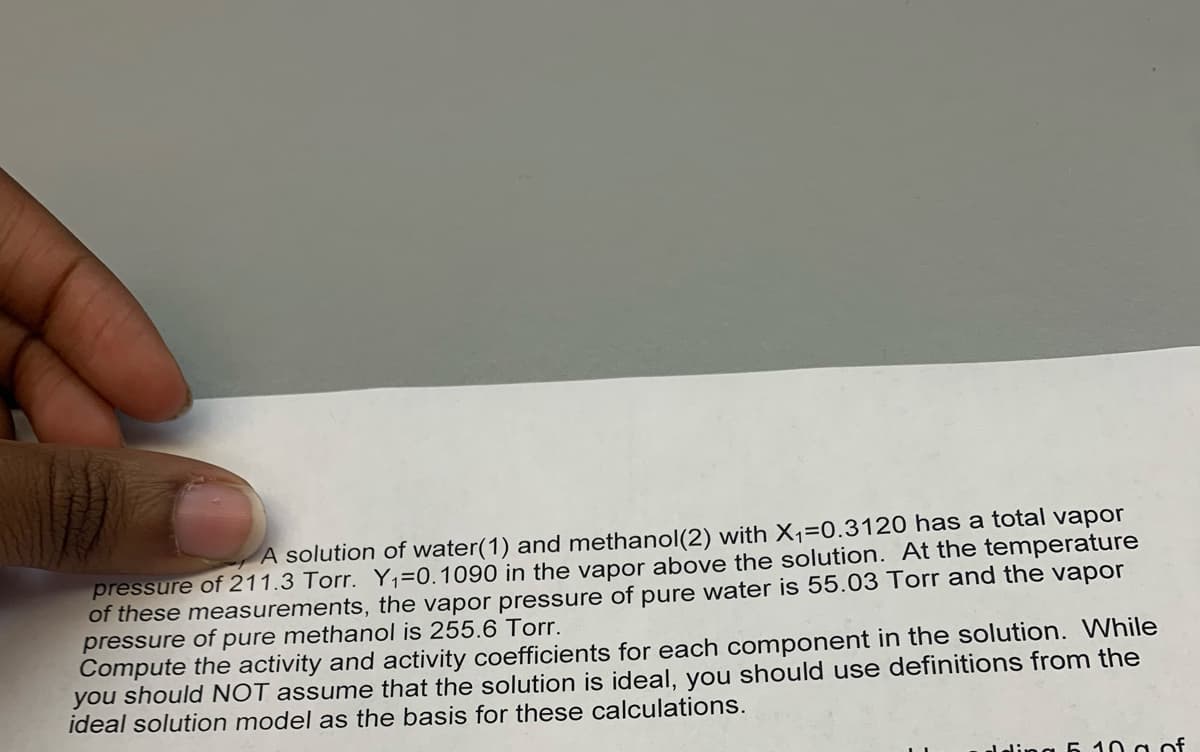A solution of water(1) and methanol(2) with X1=0.3120 has a total vapor pressure of 211.3 Torr. Y,=0.1090 in the vapor above the solution. At the temperature of these measurements, the vapor pressure of pure water is 55.03 Torr and the vapor pressure of pure methanol is 255.6 Torr. Compute the activity and activity coefficients for each component in the solution. While you should NOT assume that the solution is ideal, you should use definitions from the ideal solution model as the basis for these calculations.
A solution of water(1) and methanol(2) with X1=0.3120 has a total vapor pressure of 211.3 Torr. Y,=0.1090 in the vapor above the solution. At the temperature of these measurements, the vapor pressure of pure water is 55.03 Torr and the vapor pressure of pure methanol is 255.6 Torr. Compute the activity and activity coefficients for each component in the solution. While you should NOT assume that the solution is ideal, you should use definitions from the ideal solution model as the basis for these calculations.
Introduction to Chemical Engineering Thermodynamics
8th Edition
ISBN:9781259696527
Author:J.M. Smith Termodinamica en ingenieria quimica, Hendrick C Van Ness, Michael Abbott, Mark Swihart
Publisher:J.M. Smith Termodinamica en ingenieria quimica, Hendrick C Van Ness, Michael Abbott, Mark Swihart
Chapter1: Introduction
Section: Chapter Questions
Problem 1.1P
Related questions
Question

Transcribed Image Text:A solution of water(1) and methanol(2) with X1=0.3120 has a total vapor
pressure of 211.3 Torr. Y,=0.1090 in the vapor above the solution. At the temperature
of these measurements, the vapor pressure of pure water is 55.03 Torr and the vapor
pressure of pure methanol is 255.6 Torr.
Compute the activity and activity coefficients for each component in the solution. While
you should NOT assume that the solution is ideal, you should use definitions from the
ideal solution model as the basis for these calculations.
ling 5 10 a of
Expert Solution
This question has been solved!
Explore an expertly crafted, step-by-step solution for a thorough understanding of key concepts.
This is a popular solution!
Trending now
This is a popular solution!
Step by step
Solved in 2 steps with 2 images

Knowledge Booster
Learn more about
Need a deep-dive on the concept behind this application? Look no further. Learn more about this topic, chemical-engineering and related others by exploring similar questions and additional content below.Recommended textbooks for you

Introduction to Chemical Engineering Thermodynami…
Chemical Engineering
ISBN:
9781259696527
Author:
J.M. Smith Termodinamica en ingenieria quimica, Hendrick C Van Ness, Michael Abbott, Mark Swihart
Publisher:
McGraw-Hill Education

Elementary Principles of Chemical Processes, Bind…
Chemical Engineering
ISBN:
9781118431221
Author:
Richard M. Felder, Ronald W. Rousseau, Lisa G. Bullard
Publisher:
WILEY

Elements of Chemical Reaction Engineering (5th Ed…
Chemical Engineering
ISBN:
9780133887518
Author:
H. Scott Fogler
Publisher:
Prentice Hall

Introduction to Chemical Engineering Thermodynami…
Chemical Engineering
ISBN:
9781259696527
Author:
J.M. Smith Termodinamica en ingenieria quimica, Hendrick C Van Ness, Michael Abbott, Mark Swihart
Publisher:
McGraw-Hill Education

Elementary Principles of Chemical Processes, Bind…
Chemical Engineering
ISBN:
9781118431221
Author:
Richard M. Felder, Ronald W. Rousseau, Lisa G. Bullard
Publisher:
WILEY

Elements of Chemical Reaction Engineering (5th Ed…
Chemical Engineering
ISBN:
9780133887518
Author:
H. Scott Fogler
Publisher:
Prentice Hall


Industrial Plastics: Theory and Applications
Chemical Engineering
ISBN:
9781285061238
Author:
Lokensgard, Erik
Publisher:
Delmar Cengage Learning

Unit Operations of Chemical Engineering
Chemical Engineering
ISBN:
9780072848236
Author:
Warren McCabe, Julian C. Smith, Peter Harriott
Publisher:
McGraw-Hill Companies, The